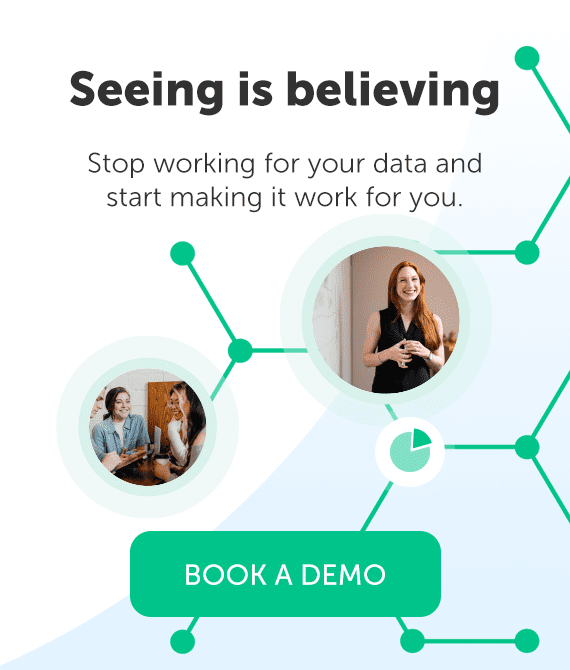Every day, valuable hours are stolen from your professionals by the simple act of typing notes, contacts, and activities into a CRM. This hidden drain is the #1 killer of productivity and CRM ROI. Instead of deepening client relationships, uncovering cross-selling opportunities, or advancing new pursuits, your highly skilled people are stuck doing admin work that adds no direct value.
In this article, we’ll quantify the real damage manual CRM data entry inflicts on productivity, adoption, and firm-wide growth, and share a definitive solution to eliminate it entirely. The goal is to free your professionals to focus fully on client engagement and creating new opportunities for growth across your firm.
Table of contents
The vicious cycle: how manual data entry sabotages your growth
Manual CRM data entry might seem like a tedious chore, but in reality it sets off a cascading chain reaction that undermines productivity, data quality, adoption, and ultimately growth. The more your team spends time entering information by hand, the less they trust or use the system, and the less reliable your firm’s forecasts and strategy become. Here’s how the cycle plays out:
It steals time from client-facing work
Manual data entry robs your team of the time they should be spending on client-facing work and growth activities. Instead of advancing new pursuits and building relationships, they’re stuck typing notes, logging calls, and updating contact details.
Salesforce’s State of Sales Report found that 70% of time is consumed by administrative tasks rather than client engagement, a pattern that extends well beyond sales teams into professional services. Deloitte’s 2025 Global Human Capital Trends report highlights the same problem, with 41% of workers reporting that they spend part of every day on tasks that don’t directly contribute to organizational value.
Those lost hours turn directly into lost billables and missed revenue. Time that should be dedicated to clients and matters is instead consumed by low-value admin work, reducing both productivity and profitability. Every minute your professionals spend on data entry is a minute they can’t spend pursuing new matters, strengthening client relationships, or uncovering cross-selling and upselling opportunities across service lines or practice areas.
It destroys data quality
Even with the best intentions, manually entered CRM data is incomplete, inconsistent, and prone to human error. Your professionals will always prioritize client work over admin, which means meeting notes go missing, contact records lose context, and relationship insights get scattered across inboxes and calendars.
This is one of the most persistent manual data entry problems for professional services firms, and it makes it nearly impossible to improve CRM data quality without rethinking how information is captured in the first place.
It tanks CRM adoption
When your professionals see CRM as hours of tedious data entry, CRM adoption suffers. Some only log in when they’re required to, while others do the bare minimum to get by. Over time, the system you invested in to accelerate growth becomes the least-used tool in your firm.
The impact goes well beyond frustration. If your team avoids the CRM, you can’t realize the return on your investment, and you can’t get the visibility you need into relationship activity, pursuit progress, and opportunities developing across service lines and practice areas.
It leads to unreliable forecasts
When your CRM records are incomplete or inaccurate, the reports and dashboards you rely on can’t be trusted. You can’t make confident decisions about hiring, resource allocation, or growth planning if CRM data quality is poor.
This problem is magnified in professional services firms, where sustainable growth depends on coordinating efforts across service lines, practice areas, or regions. If your CRM doesn’t capture the full picture of client activity, you can’t see where cross-selling or upselling opportunities exist or which new matters deserve priority. The same is true for key account management. Without accurate data, your client teams can’t get a clear view of all the interactions happening across regions and services, which makes it harder to align pursuit strategies or strengthen existing relationships.
Instead of working from a single, trusted view of the client, you’re left piecing together partial information and leaning on anecdotes. Those blind spots weaken your ability to execute your growth strategy. Firms that automate CRM data entry avoid these pitfalls. With complete, accurate data flowing into your system, you can trust your forecasts, manage key accounts more effectively, and align growth strategies across practice areas.
The old “solutions”: why traditional best practices fail
Professionals have been trying to “fix” CRM data entry for years with incremental adjustments. But none of these approaches improve CRM adoption, because they don’t address the core problem: your highly skilled people shouldn’t be wasting time on manual data entry at all.
“Better training & stricter mandates”
It might seem logical to double down on training or set stricter mandates for CRM usage. But when you do, morale takes a hit. Professionals know their time is better spent advancing new pursuits and strengthening client relationships, not typing activity logs. Training programs can sharpen technical skills, but they don’t change the fact that manual data entry is low-value work that drags down productivity. The Microsoft Work Trend Index 2024 confirms that 68% of employees already struggle with the pace and volume of work, and additional administrative burdens only make that pressure worse.
“Data cleansing projects”
Firms often respond to poor CRM data quality with cleansing projects or outsourcing updates. Sometimes this means hiring consultants, and other times it means assigning junior staff or even interns to manually update records. While these efforts can give the database a short-term boost, they do little to improve CRM data quality in a lasting way. They are costly, disruptive, and a poor use of talent that could be focused on higher-value work.
The bigger issue is that the improvements don’t stick and CRM adoption lingers as an ongoing challenge. Within months, data decay creeps back in as contacts change roles, email addresses become invalid, and new meetings and relationships go unlogged. By the time the next reporting cycle rolls around, the CRM is once again riddled with gaps and inaccuracies. The same conversations about cleaning up the system start all over again, draining more time and resources without ever solving the underlying problem. As long as your professionals are responsible for typing information into the system, your CRM will always be vulnerable to inconsistency, error, and decay.
Industry research consistently links CRM discipline with stronger long-term business performance, a relationship also highlighted in HubSpot’s analysis of CRM user adoption.
The real solution: a “zero-touch” automated data capture strategy
Incremental improvements can tidy up the system, but they don’t create lasting change in CRM adoption. Firms that want reliable data and stronger ROI have to automate CRM data entry and move beyond manual processes once and for all. A zero-touch approach does just that, taking the burden off your professionals and ensuring the system finally delivers on its promise.
How automated data capture works
Zero-touch automation takes the burden of data entry off your professionals. Tools like Introhive integrate with email, calendar, and collaboration systems and quietly capture the who, what, and when of every client interaction. These details are automatically logged against the correct client or matter record in your CRM, keeping activity current without placing extra work on your professionals.
The benefits of 100% automation
Compared to manual processes, automated CRM data entry elevates both the quality of your data and the value the system delivers to your professionals and to your firm:
- Adoption without resistance: Because activity is captured automatically, your team doesn’t see CRM as a burden. CRM adoption rises naturally without mandates or compliance checks.
- Trust in the data: Leaders can make decisions with confidence, knowing the system reflects reality rather than a partial picture. Automation doesn’t just save time, it helps improve CRM data quality to a level that manual processes can never sustain.
- Time back for client work: Freed from admin, your professionals can dedicate more hours to client engagement, new pursuits, and billable work.
The Forrester Journey to AI-Powered CRM study found that organizations with higher data readiness and greater adoption of automation consistently achieve stronger outcomes from their CRM investments. That’s because when data capture is effortless, if not invisible, your professionals stop seeing CRM as an obstacle and can leverage its full potential to drive growth.
The business impact of eliminating CRM data entry
Give 5+ hours back to every seller, every week
If you think about the time it takes to type notes, log meetings, and update contacts, it’s easy to see how professionals lose hours every week to CRM data entry. Over the course of a year, that adds up to more than six weeks of lost time per person. Those are weeks that could otherwise be billed to clients, invested in preparing for pitches, strengthening relationships, or uncovering new matters.
When CRM data capture happens automatically, you give that time back. Instead of wrestling with admin, your professionals can focus entirely on client engagement and business development, multiplying the impact of every hour worked.
Gain a real-time view of your new pursuits and engagements
Manual entry means your CRM is almost always behind. Meetings get missed, follow-ups slip through the cracks, and reporting ends up showing outdated information. Leaders are left making decisions with only part of the picture, undermining the ability to plan growth with confidence, from resourcing matters to setting revenue targets.
Automated data capture fixes this by recording every client interaction as it happens. With accurate, timely data flowing into your CRM, reports finally reflect the true state of engagement across matters, service lines, and regions.
Layering relationship intelligence on top of that accurate data unlocks even greater value in that you can identify whitespace opportunities across service lines, pinpoint the warmest paths to key stakeholders, monitor relationship strength and account health in real time, and spot declining engagement early enough to re-engage and prevent churn.
Unlock relationship intelligence you never knew you had
When every meeting, email, and call is automatically captured, you can finally see the full network of relationships across service lines, practice areas, offices, and regions. What was once scattered and invisible becomes a firm-wide asset. With this visibility, you can coordinate account strategy more effectively, uncover opportunities for collaboration, and strengthen client relationships in ways that were previously impossible to scale.
Mapping your relationships across the entire organization often reveals connections you didn’t know existed: a partner’s long-standing contact in a target company, a cross-practice relationship that could support a new pursuit, or a client stakeholder who engages more deeply with one service line than another. With that intelligence in hand, you can coordinate account strategy more effectively to drive new revenue.
Your goal isn’t better data entry – it’s better data
Growth in professional services depends on having the right insights at the right time. You need a clear picture of client engagement, confidence in your forecasts, and visibility into opportunities across service lines and practice areas. None of that is possible if your CRM relies on manual data entry.
Training programs, usage mandates, and clean-up projects might patch the system temporarily, but they do not solve the problem. The only way to have data your professionals can trust, while freeing them from low-value admin work, is automation.
When you remove CRM data entry from the equation, you give your teams more time for clients and pursuits, while building a CRM that actually supports growth. With accurate, complete, and timely data, you can strengthen relationships, plan with confidence, and drive higher CRM adoption, creating a foundation for sustained growth across service lines and key accounts.
Ready to see how zero-touch automation can transform your CRM into a growth platform? Book a demo with the Introhive team to see how it works in practice.





